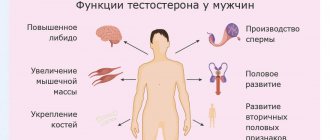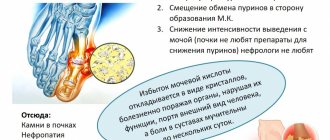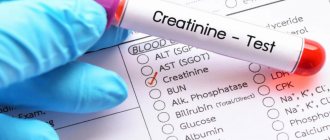How does the body produce creatinine?
The content of the article
Creatine is formed from creatine. Creatine is a nitrogen-containing carboxylic acid synthesized in muscles, kidneys, and pancreas. Sometimes it is additionally taken by athletes as an auxiliary nutritional supplement.
During fatigue, muscles convert creatine into energy, which powers muscle contractions. As a result, creatinine is obtained as the final product of metabolism. Creatinine is then released into the blood and excreted from the body through the urine of the kidney.
Although creatinine does not actively benefit or harm the body, the amount of creatinine in the blood can be measured to assess kidney health. For this reason, doctors often use a creatinine test to screen for chronic kidney disease (CKD) or kidney failure.
Purpose and circulation of creatinine
All chemical compounds circulating in the body can be divided into those that are constantly included in the metabolism in the form of various metabolites that transform into each other, and those substances that belong to the group of waste waste. The latter are subject to mandatory removal from the body. Blood creatinine is considered one of the few representatives of waste substances that exhibit toxic properties to tissues. Since its formation occurs constantly, it must be excreted just as regularly.
The central organs and tissues that regulate its metabolism are the kidneys, liver and muscles. Creatinine metabolism is designed in such a way that primary formation occurs in muscle tissue. It contains creatine phosphate, which breaks down during muscle contractions to produce a powerful flow of energy needed to perform movements and loads. Creatine phosphate is formed in the liver by combining the amino acid creatine with a phosphoric acid residue (phosphorylation process), from where it is sent through the bloodstream to the muscles. After the breakdown of creatine phosphate, creatinine is formed, which is excreted by the kidneys in urine.
Important to remember! The reasons for the increase in creatinine may be due to a violation of any of the stages of its circulation and metabolism!
Why is a creatinine test prescribed?
Creatinine testing is used to evaluate the kidneys' ability to filter blood. Most often it is prescribed for:
- suspected development of renal failure;
- any kidney diseases - pyelonephritis, polycystic disease, urolithiasis, glomerulonephritis;
- severe injuries or burns;
- any injuries, atrophy or muscle tears;
- diseases of the endocrine system;
- diseases of the cardiovascular system;
- acute inflammatory diseases;
- sepsis;
- postoperative period.
Indicator norm
It is logical that the creatinine norm cannot be the same for all people. Its fluctuations depend on gender, age and some other factors given below. Generally accepted standards from which to base when assessing this component of a biochemical blood test are given in the table. Units of measurement are mmol/l.
| Category of people | Infants | School age children | Women | Men |
| Normal indicators | 46-106 | 28-63 | 45-80 | 75-110 |
What is a good creatinine level?
In most cases, the normal range of creatinine found in the blood for people with healthy kidneys is:
| Age/gender | Normal blood creatinine value |
| Newborn babies | 20 - 75 µmol/l |
| Under 1 year | 15 – 37 µmol/l |
| 1 – 3 years | 21 - 36 µmol/l |
| 35 years | 26 - 41 µmol/l |
| 5 – 7 years | 27 - 51 µmol/l |
| 7 – 9 years | 34 - 52 µmol/l |
| 9 – 11 years | 33 - 66 µmol/l |
| 11 – 15 years | 45 - 75 µmol/l |
| Over 15 years old Men Women | 60 – 105 µmol/l 42 – 80 µmol/l |
Creatinine is a product of the non-enzymatic breakdown of creatine and creatine phosphate, which is formed in muscles. It is excreted from the body by the kidneys.
Synonyms Russian
1-methylglycocyamidine, a product of the conversion of creatine phosphate, creatinine in the blood.
English synonyms
Creatinine, Creat, Serum Creat, Cre, Blood creatinine, Serum creatinine, Urine creatinine.
Research method
Kinetic method (Jaffe method).
Units
μmol/L (micromoles per liter).
What biomaterial can be used for research?
Venous, capillary blood.
How to properly prepare for research?
- Do not eat for 12 hours before the test.
- Avoid physical and emotional stress 30 minutes before the test.
- Do not smoke for 30 minutes before the test.
General information about the study
Creatinine is a residual product produced in muscles when a substance called creatine is broken down. Creatine is part of a cycle that provides the body with energy to contract muscles. After 7 seconds of intense physical activity, creatine phosphate is converted to creatine, which then turns into creatinine, which is filtered in the kidneys and excreted in the urine. Creatine and creatinine are stably produced by our body in constant quantities. Almost all creatinine is excreted by the kidneys, so its concentration in the blood is a good indicator of kidney function. The amount of creatinine produced depends on total body weight and, in particular, muscle mass. Therefore, for example, creatinine levels in men will be significantly higher than in women and children.
A small part of it (15%) is secreted by the tubules, but it is mainly produced due to filtration in the glomeruli. The level of creatinine in the blood does not go beyond the normal range until glomerular filtration rate decreases to critical values, especially in patients with low muscle mass. The creatinine level then rises.
It is precisely because of the large number of components (muscle mass, gender, age) that affect the concentration of creatinine in the blood that this study is not the best screening test for detecting renal failure. At the same time, creatinine is a more sensitive indicator of kidney disease than urea.
What is the research used for?
- To assess renal function.
- To assess the function of major organs and systems (in combination with other studies).
- To evaluate kidney dysfunction and the effectiveness of its treatment if creatinine or urea are outside the normal range and the patient has an underlying chronic disease, such as diabetes, that affects the kidneys.
- If the level of creatinine in the blood and urine is known, the creatinine clearance (Rehberg test) can be calculated - this test shows how effectively the kidneys filter small molecules such as creatinine from the blood.
- To calculate the glomerular filtration rate to confirm kidney damage.
When is the study scheduled?
- At certain intervals in case of already known kidney disease or a disease that can cause deterioration of kidney function (together with a test for urea and microalbuminuria).
- When diagnosing skeletal muscle diseases.
- Before and after the hemodialysis procedure.
- For symptoms of kidney dysfunction: weakness, fatigue, decreased attention, poor appetite, sleep problems,
- swelling of the face, wrists, ankles, ascites,
- foamy, red or coffee-colored urine
- decreased diuresis,
- problems with urination: burning, intermittency, change in frequency (predominance of nocturnal diuresis),
- pain in the lumbar region (especially on the sides of the spine), under the ribs,
- high pressure.
What do the results mean?
Reference values (creatinine norm):
Creatinine
| Age, gender | Reference values | |
| 21 - 75 µmol/l | ||
| 1 - 12 months | 15 – 37 µmol/l | |
| 1 – 3 years | 21 - 36 µmol/l | |
| 35 years | 27 - 42 µmol/l | |
| 5 – 7 years | 28 - 52 µmol/l | |
| 7 - 9 years | 35 - 53 µmol/l | |
| 9 – 11 years | 34 - 65 µmol/l | |
| 11 – 13 years | 46 - 70 µmol/l | |
| 13 – 15 years | 50 – 77 µmol/l | |
| > 15 years | male | 62 - 106 µmol/l |
| > 15 years | female | 44 - 80 µmol/l |
GFR (glomerular filtration rate): 60 and above.
Causes of increased creatinine levels
- Acute and chronic renal failure (amyloidosis, kidney damage due to diabetes, etc.).
- Failure of the cardiovascular system (myocardial infarction, cardiogenic shock, myocardial dystrophy, etc.).
- Massive destruction of muscle tissue (crash syndrome) and release of creatinine from cells.
- Burns (massive necrosis of cells with the release of their contents into the intercellular substance).
- Acromegaly.
- Gigantism.
- Hyperthyroidism.
- Dehydration (blood thickening and relative hypercreatininemia).
- Excessive physical activity.
- Excessive consumption of meat products.
- Radiation sickness.
- Obstruction of the urinary tract.
- Taking nephrotoxic drugs (mercury compounds, sulfonamides, thiazides, aminoglycoside antibiotics, cephalosporins and tetracycline, barbiturates, salicylates, androgens, cimetidine, trimethoprim-sulfamethoxazole).
- Damage to the blood vessels of the glomerular apparatus of the kidneys (glomerulonephritis), which may be a consequence of an infectious or autoimmune disease.
- Bacterial kidney infection (pyelonephritis).
- Necrosis of the tubular epithelium (acute tubular necrosis), caused, for example, by drugs or toxins.
- Prostate disease, nephrolithiasis or other factors causing obstruction of the urinary system.
- Reduced blood flow to the kidneys due to shock, dehydration, acute heart failure, atherosclerosis, or complications of diabetes.
Reasons for decreased creatinine levels
- Starvation.
- Overhydration (blood dilution – relative hypocreatininemia).
- Amyotrophy.
What can influence the result?
- Factors distorting the result Pregnancy (especially the first and second trimesters).
- Excess muscle mass, such as in some athletes (possibly elevated creatinine levels despite normal kidney function).
Creatinine is higher than normal - reasons
Physiological reasons:
- strength sports – powerlifting, bodybuilding, wrestling;
- large amount of muscle mass;
- predominance of meat dishes in the diet;
- the use of certain medications, for example, tetracycline antibiotics, non-steroidal anti-inflammatory drugs.
Pathological reasons:
- acute and chronic kidney diseases;
- diseases of the cardiovascular system;
- hyperthyroidism – excessive production of the hormone thyroxine by the thyroid gland; radiation sickness;
- oncological diseases;
- muscle injuries;
- septic shock;
- extensive burns;
- endocrine diseases.
Hypercreatinemia as a sign of disease
An increase in creatinine is called hypercreatininemia. It can act as the main diagnostic criterion or an additional sign of many different diseases. Based on the degree of increase compared to the norm, one can roughly determine the causes of this condition. In this regard, it is advisable to highlight.
Slight and moderate hypercreatininemia (exceeding the norm by several tens of units)
- Any kidney pathology complicated by degrees 1 and 2 of organ failure;
- Liver damage of a toxic, inflammatory or cirrhotic nature;
- Massive tissue necrosis with gangrene of the limbs and internal organs;
- Traumatic damage to muscle tissue, bones and extensive skin burns;
- Hyperfunction of the thyroid gland (thyrotoxicosis);
- Diabetic nephropathy due to diabetes mellitus;
- Hyperfunction of the adrenal glands (hyprecorticism);
- Myasthenia;
- Toxic effects on the body caused by exposure to harmful substances or against the background of various serious diseases (infections, purulent-septic conditions, severe injuries, intestinal obstruction, peritonitis, etc.)
- Side effects of medications that have a nephrotoxic effect;
- Autoimmune pathology with massive damage to connective tissue (rheumatoid arthritis, lupus erythematosus, vasculitis);
- Dehydration of the body caused by insufficient fluid intake or excessive fluid loss;
- Decompensated heart failure with severe stagnation in the systemic circulation;
- Toxicosis complicating the course of pregnancy.
Severe hypercreatininemia (exceeding the norm by 100 mmol/l or more)
- Kidney diseases accompanied by stage 3-4 renal failure;
- Massive muscle destruction in muscular dystrophy;
- A common inflammatory process in the muscles (generalized myositis);
- Syndrome of positional or prolonged compression of large muscle masses. This group of causes also includes reperfusion syndrome, which forms after the resumption of blood circulation in the extremities, the vessels of which were blocked by blood clots;
- Leptospirosis and other severe infections.
Important to remember! Blood creatinine is one of the most important diagnostic criteria for assessing the functional abilities of the kidneys. Therefore, in practice, we most often encounter precisely this reason for its increase!
Creatinine decreased
Conditions in which a decrease in plasma creatinine levels is recorded are extremely rare. Their appearance indicates a disruption of metabolic processes, accompanied by profound disorders of protein metabolism in the body in general, or isolated in muscle tissue. If hypercreatinemia mainly depends on the functional capacity of the kidneys, then in the case of hypocreatinemia (decrease in creatinine level), their condition does not play a role. Consequently, the main mechanism should be such a depletion of energy reserves in the body that protein resources, which are most abundant in the muscles, are used to repay them. A decrease in creatine phosphate reserves naturally leads to a decrease in the concentration of its metabolites in the blood, which is creatinine.
Normal creatinine
All creatinine cannot be filtered and excreted by the kidneys. This is due to the fact that it is constantly released into the blood while the muscle tissue is viable. Blood plasma should contain a relatively stable concentration of creatinine, which may vary depending on age, muscle activity and nutrition. Therefore, there are maximum and minimum limits of normal creatinine, which take into account all these points and indicate the normal functioning of organs.
To eliminate errors in the results of a biochemical blood test based on creatinine levels, be sure to adhere to the general rules for blood sampling. The study must be carried out in the morning on an empty stomach. It is advisable to avoid strong muscle strain and overheating or hypothermia before directly drawing blood.
To illustrate the variations in creatinine standards, they are presented in table form:
| Age and gender | Small children | Pupils | Men | Women |
| Creatinine norm in µmol/l | 45-105 | 27-62 | 74-110 | 44-80 |
Creatinine norm in women
Plasma creatinine concentrations in women should be lower than in men. This is due to the physiological mechanisms of its formation, distribution and circulation in the blood.
The mechanisms of this phenomenon are as follows:
- A woman's muscle mass is less than that of a man;
- Less muscle strain;
- The activity of metabolic processes in the female body is reduced;
- Food products from the female diet contain less exogenous creatinine entering the body;
- The influence of sex hormones and pregnancy.
Creatinine norm in men
The creatinine of the male body should almost always be higher than that of women of the same age group. This is due to lifestyle characteristics and differences in the functioning of organs and systems. Age characteristics also affect the process of creatinine metabolism, both towards its increase and decrease. Recently, many men have been visiting gyms and using doping products containing creatine to increase muscle performance. This must be taken into account when assessing the creatinine norm.
Normal creatinine level in children
The concentration of creatinine in a child’s plasma largely depends on his age. The main fluctuations in this indicator are associated with growth activity and the degree of increase in muscle mass over a certain period of time. Newborns, due to the high stress that their body had to experience during childbirth, have creatinine levels the same as in adults. The same feature is typical for adolescents, which is explained by the active growth of the body. School-age children grow relatively steadily, so their creatinine levels are slightly lower than adults.
References
- Clinical protocol for diagnosis and treatment of acute renal failure, 2014. - 24 p.
- Kucher, A.G., Kayukov, I.G., Yesayan, A.M. and others. The influence of the quantity and quality of protein in the diet on kidney activity. Nephrology, 2004. - Vol. 8(2). — P. 14‐34.
- KDIGO practice guidelines for the diagnosis, prevention and treatment of mineral and bone disorders in chronic kidney disease (CKD-MBD). Summary of recommendations. Nephrology, 2011. - T. 15(1). — P. 88‐95
- Nephrology. National leadership / ed. ON THE. Mukhina. - M.: GEOTAR-Media, 2009. - 720 p.
How to lower creatinine
Creatinine can be effectively reduced only by eliminating the cause of its increase and correcting lifestyle. To do this you need:
- It is imperative to conduct a thorough diagnosis to determine the condition of internal organs and muscle tissue;
- For long-term and persistent hypercreatininemia, hospitalization in medical institutions of a certain profile is indicated, where treatment will be prescribed depending on the disease and cause;
- Selection of proper nutrition. Protein foods of animal origin and fats, salt, marinades, smoked foods, seasonings, whole milk and alcohol are almost completely excluded. The diet is enriched with vegetable oils, vegetables and fruits;
- Correction of the amount of fluid consumed. If creatinine is high due to renal pathology, water intake is minimized. In all other cases, high-quality water consumed in the right quantity will help reduce this indicator;
- Correct motor mode. Adjusted depending on the general condition of the person;
- Traditional medicine: various mixtures of medicinal herbs and plants, rice water;
- Taking medications that affect protein metabolism (lespefan, ketosteril, lespinefril);
- Methods of extracorporeal detoxification and hemodialysis (artificial kidney). An extreme measure required if creatinine is elevated to critical levels.
Creatinine is a reliable indicator of the functional abilities of internal organs. Its assessment and correction should be carried out exclusively by specialists.
Interpretation of results
For patients of different gender and age, their own reference values have been established. When interpreting the results, the amount of muscle mass, level of physical activity and other factors are also taken into account. With age, uric acid concentrations decrease as creatinine synthesis in the kidneys changes. The research can be carried out by fermentation or chemical methods.
Based on the test results, diseases of the kidneys, thyroid gland, skeletal muscles, intestinal obstruction and other pathologies are detected. Increased performance is also characteristic of serious muscle injury. Decreased levels may indicate insufficient physical activity or lack of nutrition. In most cases, the results of one test are not enough for accurate diagnosis and selection of effective treatment methods. If deviations from the norm are detected, a comprehensive examination is prescribed. When diagnosing, the results of all examinations are taken into account. This makes it possible to avoid mistakes, quickly make an accurate diagnosis and begin treatment. It must be taken into account that sometimes in the presence of renal failure, indicators remain within normal limits for several years.








